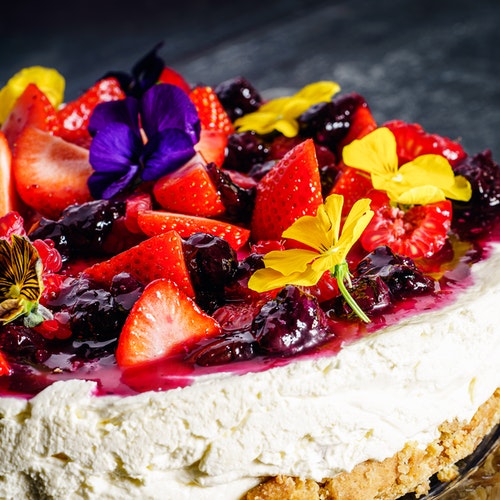Same day flower delivery available
Same day flower delivery available
Many of us enjoy cooking, and those who don’t certainly like to eat. We’re here to appeal to both of these groups by showing you how you can use flowers to not only add to the taste of your food, but also the look!
You probably didn’t know some of the colourful flower petals are edible. There’s multiple uses for them - you could put them on top of a salad, sprinkle them as garnishes on baked goods, or even use them as an ingredient in a stir-fry!

Most edible flowers are very delicate to use, so we recommend picking them just before you plan to use them. Gently wash without damaging them & brush off any excess dirt or small hidden insects. Keep the dish simple with generous floral garnishes and don’t be too heavy handed with the petals ( they may overpower the dish).
Some of the best edible flowers are the blossoms of vegetables and herbs that you can grow in your garden. They’re easy to care for with lots of sunshine, well-draining soil and reasonable watering. These make for a great addition to any garden as they also attract insects and pollinators.
Not all flowers are safe to eat, so ensure you check before you grow or consume any. We also recommend you avoid flowers if you suffer from hayfever or other allergies, and also check if they’ve been sprayed as some can be poisonous.

Flowers we recommend growing to eat are::
Nasturtiums are a culinary favourite as their varieties make for beautiful toppings on cakes or pastries, with warm bright colours. The flower along with the leaves can be eaten either raw or cooked and the seed pod can be pickled, similar to capers. The blooms have a tangy yet peppery flavour with a spicy profile and a zesty kick at the end. Tender enough to use as a salad green, blend well in a simple potato salad with chives or blitz it into an appetising pesto, this really is a versatile bloom for a variety of dishes.
Pansies are small delicate blossoms that typically have a wintergreen, fresh minty flavour in interesting hues of purple, blue and yellow. From festive tartlets to summery vegetable salads and hors-d’oeuvres, incorporate pansies for a pop of colour, texture and nutrition, as pansies are a rich source of several antioxidant compounds and anti-inflammatory properties.

This is one you probably have heard of (tea, anyone?) Chamomile is a floral herb that looks like a daisy but has an earthy flavour. They are best used in cake batters, bread, and rice puddings, but can also be churned into ice cream. Just like any other edible flower you can sprinkle these flowers onto salads and into soups for a more aromatic taste.
Zucchini flowers obviously come from the zucchini plant and are a bright yellow flower. They can be eaten raw as a garnish, chopped in salads or a favourite method is to stuff them with ricotta or goats’ cheese, batter and fry them until the petals become lightly crispy. If you’re feeling a little indulgent, you can also add them to a summertime favourite pizza, a quesadilla or chopped and mixed in with rice pilaf.
Lavender has some of the most intense and sweet fragrant flavour notes of all the flowers. There are endless possibilities of how the combination of colour and aroma make the lavender a particularly desirable addition to sweet or savoury dishes. That said, we recommend pairing lavender with tangy citrus fruits or drinks to bring out its true flavour profile. Another option is using it with sea salt, fresh thyme or rosemary, paired with proteins like lamb.
Do you have a personal favourite when it comes to edible flowers? Share it with us on Facebook or on Instagram using the hashtag #AlwaysInterflora and #InterfloraAU.